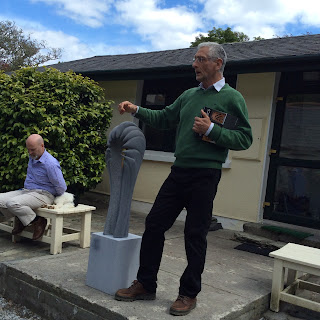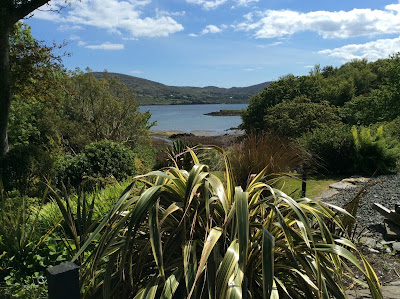 |
| Adrian and sculpture head |
Our Potters Council group on tour in Ireland met a number of local ceramics artists.
First, our hard working host at the Kinsale Pottery and Art Center, Adrian Wistreich. He organized the many potters who shared their expertise with us in workshops or in presentations. Adrien himself often uses paper clay. He has a well stocked gallery of his own work above the studios.
This wildly flamboyant paper clay basket is a good example Adrian's work.
He also makes these tiny salt and pepper cellars with wisp-like spoons that he boxes and sells - his "bread and butter" ware.
One evening, Kathleen Standen came to the art center to speak. The work she brought to show us was a large, chunky, abstract sculpture. She is inspired by the manmade and marine forms she sees in the ports of Ireland and England - buoys and shipping gear, crusted and worn by salt and waves.

Kathleen has written an excellent book, all about working with clay additives to create unusual textures and forms.
 |
| A bowl by Jim Turner |
There was too much to tell in one sitting. He has done amazing work, and led a fascinating life. Jim's work has gone through many phases, exploring myriad forms, techniques and themes. Pictured here are just two examples: a bowl and a towering sculpture.
 |
| Zengdi, Jim Turner's hand built sculpture at Mill Cove House sculpture garden |
 |
| Sarah Roberts leading our workshop |
Adrian introduced us to Sarah Roberts, the porcelain clay sculptor of delicately colored reliefs inspired by the sea coast of Ireland. See my earlier post on the workshop with Sarah.
 |
| Julian Smith with one of his raku fired female torsos |
Julian Smith also shared his expertise in a workshop at the Kinsale studios. We spent a day watching him fire up pieces in his homemade raku kilns, also described in an earlier post.
We met the retired, or so he claims, potter Cormac Boydell in our Bantry hotel where he brought his newer work to show and also joined us for dinner. I was lucky to sit next to him and get to know more about him, including that ice cream and jelly is a favorite dessert of his since childhood.
But perhaps more important to know, Cormac trained as a geologist, and this background has influenced his work in formulating glazes. Each piece is precisely documented, and often fired many times to achieve the desired glaze effect.
He showed us thick wall platters that he forms entirely by hand - no tools. The edges are glazed with a gleaming golden lustre, but look rough and ragged. Incised and painted on the surface are images. The two pictured here are inspired by the familiar old china Willow pattern.
Far out on the beautiful Beara Peninsula, you will find the Mill Cove Gallery, featuring work by Irish potters.
Gallery director John Goode welcomed us, graciously opening the gallery especially for us on one of its closed days.

John Goode has published two books, pictured here. Mostly illustrations, with artist statements and bios, it contains an impressive number of talented artists working in clay, considering the size of Ireland and its small population.
We scrutinized a multi-roomed gallery building filled with ceramics and paintings, and four acres of gardens where clay sculptures were displayed on the landscaped hillside. A view of the ocean from the front of the house was breathtaking.
 |
| Onlookers, Sandra McGowen |
Here are a few examples of sculptures in the gallery and garden, all clay except for Ayley Lalor's which is cement.
 |
| Ayley Lalor |
 |
| Eleanor Swan |
 |
| Julian Smith |
This was the first Potter's Council trip to Ireland. I think for all who came and journeyed through the lovely and historically fascinating country, and took part in all the ceramic workshops and experiences, it was worthwhile. For many reasons, I can say confidently for myself, that I will remember this trip - forever!











No comments:
Post a Comment
please leave feedback. thanks!